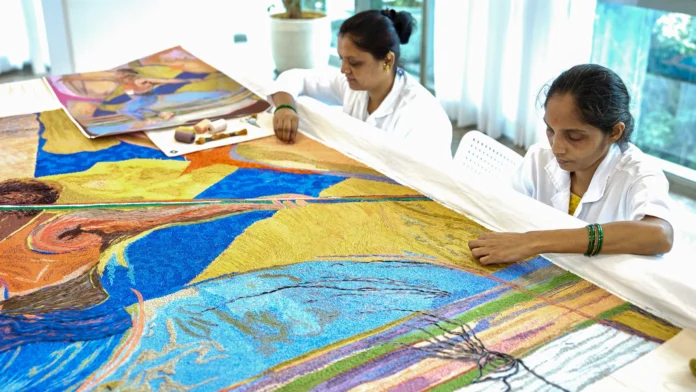During the Paris Olympics, Indian art found a prominent place, celebrating the country’s rich Olympic history. On August 9, the 7th Arrondissement Town Hall in Paris hosted an event organized by the JSW Group to honor Indian athletes from past and present. This celebration featured artworks that highlighted pivotal moments in Indian Olympic history, bridging the past with the present.
The event showcased several notable pieces, including artworks by Sujata Bajaj and Chanakya School of Craft. Bajaj’s canvas drew considerable attention. Her work, a vibrant fusion of the Indian flag and the Olympic rings, utilized strong hues of orange, green, blue, white, and red. She explained that her piece symbolized the universality of the Olympic message, with the fluid colors reflecting world maps from a distant perspective.
Another highlight of the exhibition was a series of artworks that featured prominent Indian athletes like Neeraj Chopra and Sakshi Malik. These artworks provided a visual tribute to their achievements and the broader legacy of Indian sportsmanship. The portrayal of these athletes underscored the significance of their contributions to India’s Olympic success.
The event was not only a celebration of Indian artistry but also a reflection on India’s journey in the Olympics. It traced the country’s Olympic history from 1920 when three Indian athletes traveled on the SS Mantua to compete in the Summer Olympics in Antwerp, Belgium. This historical reference provided a poignant backdrop to the contemporary achievements celebrated through the art on display.
Attendees of the event were treated to a visual narrative that spanned over a century of Olympic participation. The artwork not only honored individual athletes but also celebrated the collective progress of Indian sports. The vibrant and thoughtful designs conveyed the spirit of determination and excellence that defines Indian participation in the Olympics.
The celebration in Paris underscored India’s growing influence and presence on the global sporting stage. By commemorating past successes and ongoing achievements through art, the event highlighted the importance of cultural and historical reflection in the context of global sports.
The artwork by Chanakya School of Craft complemented the exhibition with its focus on traditional and contemporary interpretations of Olympic themes. The blend of different artistic styles and historical contexts provided a rich and diverse portrayal of India’s Olympic journey.
The Paris event exemplified how art can bridge cultural and historical gaps, offering a unique perspective on sports achievements. It allowed both attendees and participants to engage with India’s Olympic legacy in a meaningful way, celebrating the intersection of culture and athletics.
As Indian athletes continued to compete in the Paris Olympics, the art exhibition served as a reminder of the country’s proud sporting history. It celebrated not only the individual achievements of athletes but also the broader narrative of India’s Olympic participation and its evolution over the years.
Overall, the event was a resounding success, bringing together art, history, and sports in a celebration of Indian Olympic achievements. It highlighted the enduring impact of these moments and the continued relevance of art in commemorating and reflecting on the significance of global sporting events.
The Paris exhibition also featured interactive elements, allowing visitors to engage more deeply with the stories behind the artworks. Digital displays provided additional context about the historical and cultural significance of the pieces, while artist talks offered insights into the creative processes behind the artwork. This interactive approach enriched the visitor experience, making the Olympic history and achievements of Indian athletes more accessible and engaging.
The event attracted a diverse audience, including art enthusiasts, sports fans, and members of the Indian diaspora. The presence of key figures from the Indian sports community and local dignitaries added to the occasion’s significance. Their participation underscored the importance of celebrating sports achievements within a broader cultural and artistic framework.
One of the notable aspects of the exhibition was the emphasis on the evolving nature of Indian sports. The artwork not only celebrated historical achievements but also highlighted the ongoing contributions of current athletes. This dual focus created a dynamic narrative that linked past accomplishments with contemporary successes, emphasizing the continuity of India’s Olympic journey.
The event also served as a platform for discussing the future of Indian sports. Conversations around the artworks sparked dialogue about the potential for further growth and development in Indian athletics. These discussions reflected a broader interest in enhancing support for athletes and fostering a culture of excellence and innovation in sports.
In addition to celebrating individual athletes and historical milestones, the exhibition highlighted the role of art in preserving and promoting cultural heritage. By integrating artistic expression with historical and athletic achievements, the event demonstrated how creative endeavors can contribute to a richer understanding of national identity and pride.
The exhibition’s success in Paris has set a precedent for future cultural events that aim to celebrate sporting achievements through art. It showcased how art can play a vital role in documenting and commemorating significant moments in sports history, offering new perspectives and appreciation for the achievements of athletes.
As the Paris Olympics continued, the celebration of Indian Olympic history through art remained a prominent feature of the cultural landscape. The event not only honored past achievements but also inspired a new generation of athletes and artists to continue contributing to India’s legacy on the global stage.

